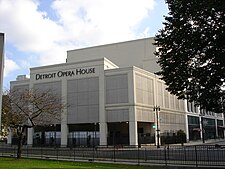Detroit Opera House

Detroit Opera House overlooks Grand Circus Park.
|
|
| Former names | Grand Circus Theater (1960s–1985) Broadway Capitol Theater (1934–1960s) Paramount Theater (1929–1934) Capitol Theater (1922–1929) |
|---|---|
| Location | 1526 Broadway Street Detroit, Michigan |
| Coordinates | 42°20′11″N 83°2′55″W / 42.33639°N 83.04861°WCoordinates: 42°20′11″N 83°2′55″W / 42.33639°N 83.04861°W |
| Type | Opera |
| Capacity | 2,700 |
| Construction | |
| Opened | January 22, 1922 |
| Renovated | 1996 |
| Website | |
|
Detroit Opera House
|
|
| Part of | Grand Circus Park Historic District (#83000894) |
| Designated CP | February 28, 1983 |
Detroit Opera House official site
The Detroit Opera House is an ornate opera house located at 1526 Broadway Street in Downtown Detroit, Michigan, within the Grand Circus Park Historic District. The 2,700-seat venue is the home of productions of the Michigan Opera Theatre and a variety of other events. The theatre was originally designed by C. Howard Crane, who created other prominent theatres in Detroit including The Fillmore Detroit, the Fox Theater and the Detroit Symphony's Orchestra Hall. It opened on January 22, 1922.
The building underwent an extensive restoration which took place under the control of architect Eric J. Hill. It reopened in 1996.
Over the years, opera has been presented at a variety of venues in Detroit - the Old Detroit Opera House (1869–1963) at Campus Martius, the Whitney Grand Opera House (Garrick Theatre) at Griswold Street and Michigan Avenue, and the New Detroit Opera House (1886–1928) at Randolph and Monroe Streets.
The Nederlander Organization, a major theatrical producer, began in Detroit with a 99-year lease on the Old Detroit Opera House in 1912.
The present Detroit Opera House opened in 1922 and was known as the Capitol Theatre. It was among the first of several performance venues built around Detroit's Grand Circus Park. When it opened, the Capitol was reportedly the fifth largest movie theater in the world, seating about 3,500 people. In 1929, the Capitol Theater became the Paramount Theater, and in 1934, the Broadway Capitol Theater.
During the first few decades of its history the theater presented feature films along with live entertainment including artists such as jazz legends Louis Armstrong and Duke Ellington. Later the Broadway Capitol converted to a movies-only policy. Following a minor restoration in the 1960s, the building became the 3,367-seat Grand Circus Theatre. The theater closed in 1978 after surviving several years exhibiting second-run and soft-core porn films. It reopened again briefly in 1981, but closed after a minor fire 1985 caused damage.
...
Wikipedia
